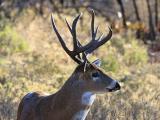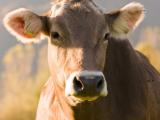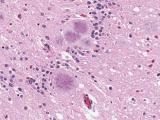Feb 10, 2004 (CIDRAP News) – US Department of Agriculture (USDA) officials said yesterday they have completed their field investigation after tracing as many cows as possible from the original herd of the nation's first cow known to have bovine spongiform encephalopathy (BSE).
Officials said they found 28 of 81 cows (or 29 with the infected cow) from the sick cow's birth herd, including 14 cows that were most likely to have eaten the same feed as the sick cow. They said the remaining 52 cows have not been positively identified but pose little risk to the public.
"We feel very confident that the remaining animals, the ones that we were not able to positively identity, represent very little risk," said Ron DeHaven, the USDA's chief veterinary officer, at a press briefing yesterday afternoon.
The 81 cows came from a dairy farm at Calmar, Alta., and were sold into the United States in September 2001. The herd included a Holstein cow that was slaughtered Dec 9 in Washington state and was later found to have BSE, or mad cow disease. The finding was announced Dec 23, triggering a wide-ranging investigation and a ban on American beef imports in many countries.
Besides the 28 cows that definitely were among the 81 from the Alberta herd, the USDA identified 220 cows that could have been among those 81, DeHaven said. Investigators also found another seven heifers that came from the same Alberta farm and entered the United States separately from the 81-cow shipment in September 2001. All those cattle, totaling 255, were sacrificed, and BSE tests were negative on all of them, DeHaven said.
DeHaven cited several reasons for believing the untraced cows pose little risk. First, many of them could have been among the 220 that couldn't be excluded from the shipment of 81 and therefore were slaughtered and tested. Second, in countries where BSE has been more prevalent, very few herds have included more than one or two sick animals. Third, any cows that couldn't walk or showed signs of brain disease at the slaughterhouse would have been condemned and not used for human food.
Also, DeHaven said, if any of the cows were slaughtered and rendered into feed, the ruminant-to-ruminant feed ban in place since 1997 would have kept their remains out of feed for cattle. And for any cows slaughtered after Jan 12 (2004), the high-risk tissues such as the brain, spinal cord, and small intestine would be removed and not used for food, under a regulation adopted after the BSE case was discovered.
As reported previously, the USDA determined that 25 cows from the 81-cow shipment were most likely to have eaten the same feed as the infected cow because they were born within a year before or after the sick cow. Investigators found 14 of those 25, which, given culling practices in the region, was more than they expected to find, DeHaven said. He called the chances of finding any more of the 25 "pretty slim at this point."
The BSE investigation led to a total of 189 sites, and herds were fully inventoried at 51 sites in Washington, Oregon, and Idaho, DeHaven said. Investigators checked the identification on more than 75,000 animals.
DeHaven also revealed that 2,000 tons of meat-and-bone meal will be dumped in landfills because it may contain protein from the infected cow—an amount vastly larger than the approximately 10,000 pounds of beef that originally were recalled because of the BSE discovery.
Steve Sundlof of the Food and Drug Administration (FDA), speaking at the news briefing, noted that the infected cow was slaughtered Dec 9. When the FDA learned of the BSE case, the agency found the two rendering plants that received parts from the sick cow and asked them to hold all materials produced between Dec 1 and Dec 23, he said. That time frame was used because "a lot of this material gets commingled after it's processed into meat and bone meal or other products," he said.
"When we looked, it turned out to be 2,000 tons of material that potentially could have been contaminated," Sundlof said.
Also at the briefing, DeHaven summarized the conclusions and recommendations of the international expert committee that reviewed the USDA's BSE investigation and response and released its report last week. But he did not predict how the USDA would respond.
The expert panel said that more BSE cases probably exist in the United States and urged a more aggressive testing program to find them. The group also recommended, among other things, that the government ban the use of high-risk cattle tissues (specified-risk materials, or SRM) not only in human food, but in animal and pet food. The panel also urged that all mammalian and poultry protein be banned from cattle feed, instead of banning just ruminant protein in feed for cattle and other ruminants.
In response to a question, Sundlof said the FDA was surprised by the recommendation to ban SRM from all animal feed. The FDA recently announced some regulatory changes in response to the BSE case, but didn't include that measure, he noted.
"We did not [take that step] because in looking at the Harvard Risk Assessment [for BSE in the United States, a USDA-commissioned study], it did not appear that that particular measure was essential to minimize BSE in this country," Sundlof said. "So we were a little bit surprised at the recommendation from the expert committee. And we're trying to understand right now why there seem to be really two different views on the SRM issue."
Sundlof noted that the Harvard study concluded that even if up to 500 BSE-infected cattle entered the United States, the disease would "vanish" within 20 years. But the FDA is considering the expert panel's report, and it "will become part of the record as we go forward with our rulemaking," he said.
Another recommendation from the expert committee was to "significantly" increase BSE testing to include older cattle that die on farms and a random sample of older healthy slaughter cattle. In response to a question, DeHaven said the USDA has not changed its goal, announced before the BSE case turned up, of testing 40,000 cattle for BSE this year. However, the agency is analyzing the panel's recommendation and may modify its surveillance plans, he added.
See also:
Transcript of Feb 9 USDA briefing
http://www.usda.gov/wps/portal/usda/usdahome?contentidonly=true&contentid=2004/02/0073.html
Feb 4 CIDRAP News story on the expert committee's report on the BSE investigation














